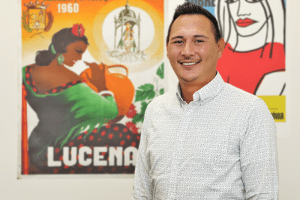For the love of language
“My goal is for students to leave the classroom using language in meaningful ways,” says Matthew Griffin, instructor of Spanish at LLCC.

Griffin grew up in a bilingual household in North Carolina. His mother is from Thailand, and his father is American. “Growing up around language and dialects allowed me to develop an ear for language and how people speak,” he explains.
“In high school I had a really fantastic Spanish teacher. She taught the language and also a lot about Spain. So I first learned about the culture of the country through the language itself. Then, I visited Spain.”
Griffin was interested in phonetics and phonology and completed a bachelor’s degree in Hispanic studies, a master’s degree in English linguistics and graduate certificates in Hispanic studies and community college instruction from East Carolina University. He is currently working on his doctorate degree in applied Spanish linguistics with a minor in second language acquisition from the University of Wisconsin – Madison.
He teaches Spanish and linguistic courses at LLCC and works with area high schools to provide their students dual credit — both high school and college credit — for Spanish classes taken at the high schools.
“The students in my classes represent diverse ages and life experiences. There are students working on the first two years of a bachelor’s degree, some are working with community members who speak Spanish and others have family that speak Spanish,” says Griffin.
“When you study another language, there are professional and financial benefits in one’s career, but also cognitive benefits. It serves as a kind of mental gymnastics. Research shows that learning another language helps students score higher on standardized tests, and it improves problem-solving and short- and long-term memory.”
When compared to apps that are available to learn languages, the classroom provides an immersive experience. “Think about how you learn your first, native language,” says Griffin. “You’re immersed in the language constantly through hearing, seeing and speaking. We speak in Spanish as much as possible in class. You don’t realize how much you understand and can do with the language until you’re actively engaged with it.”
Griffin helps his students focus on practical application of the language. “They do a project, such as creating a cover letter and resume and doing a one-on-one interview, all in Spanish.”
As part of his world language classes, students participate in language exchanges with native speakers. They have three virtual meetings over the course of a semester in which they practice speaking. “Students learn a lot of vocabulary in class, and it’s an opportunity for them to try out what they’ve learned,” he explains. “Since the people they are partnered with are from different countries, they also learn about their cultures.” He recommends that those thinking about the program “just do it.”
